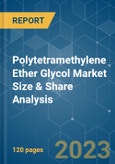The Polytetramethylene Ether Glycol (PTMEG) Market size is expected to grow from 1.24 million tons in 2023 to 1.60 million tons by 2028, at a CAGR of 5.27% during the forecast period (2023-2028).
Due to the COVID-19 outbreak, nationwide lockdowns worldwide, disruption in manufacturing activities and supply chains, and production halts negatively impacted the market. However, the conditions started recovering over time, restoring the market's growth trajectory.
Due to the COVID-19 outbreak, nationwide lockdowns worldwide, disruption in manufacturing activities and supply chains, and production halts negatively impacted the market. However, the conditions started recovering over time, restoring the market's growth trajectory.
Key Highlights
- Over the medium term, the increasing demand for thermoplastic polyurethane (TPU) and the growth in the apparel and clothing industry is expected to drive the market growth.
- However, the economic downfall in the European economies is expected to hinder the growth of the market studied.
- The emerging usage of spandex fibers in the healthcare industry and shifting trends toward bio-based products are expected to provide opportunities for the market.
- Asia-Pacific is expected to witness the highest growth rate during the forecast period.
Polytetramethylene Ether Glycol (PTMEG) Market Trends
Textile Industry is Likely to Dominate the Market
- The textile industry has been growing at a healthy rate in emerging economies like ASEAN countries, viz., India, Bangladesh, etc. It is expected to grow further over the forecast period. This is due to low manufacturing costs and the industry's significant role in trade, employment, investment, and revenue.
- Increasing demand for enhanced quality stretch fabric across various textile applications drives the demand for polytetramethylene ether glycol (PTMEG).
- According to the World Federation of the Sporting Goods Industry, compared to other industries, the past two years have shown a high recovery rate in this segment by recording high growth and equaling or outperforming pre-pandemic levels. According to the federation, in 2022, companies placed large orders in anticipation of demand and to avoid the supply chain challenges of 2021 owing to the improving consumer sentiment trends seen every month in the first half of the year.
- China is the world's largest producer and exporter of raw textile materials and garments. According to the National Bureau of Statistics of China data, the textile sector grew steadily in the first ten months of 2022. In December 2022, approximately 3.47 billion meters of clothing fabric were produced in China. In addition, Vietnam, known for its competitive clothing products, achieved a new high of USD 11.5 billion in textile exports in 2021 and ranked sixth globally.
- Germany, France, Spain, Italy, the Netherlands, and Poland are the largest European markets, accounting for nearly 75% of all EU sportswear imports worldwide.
- In India, the demand for apparel has increased with the growing consumer preference in response to the growing number of foreign textile brands. The demand has been augmented by digitalization, social networking sites, and apps, which help increase garments sales. As per some apparel manufacturers in India, the growth rate in menswear brands is 7-10%, while the growth rate of women's and kids' apparel is around 15-20%.
- Hence, owing to the abovementioned factors, the textile industry will likely dominate the market studied during the forecast period.
Asia-Pacific Region to Dominate the Market
- Currently, the Asia-Pacific region accounts for the highest market share. Due to the increasing demand from the textile industry in countries such as China, India, Japan, and the ASEAN countries, the demand for polytetramethylene ether glycol is increasing.
- China is a significant market for global textiles, automotive, and paints and coatings. Companies present in the country, multinationals, and locals are expanding their production capacities and investing in new projects to decrease their dependence on imports, thereby fueling regional energy security and autonomy.
- China has been an attractive market for athletic apparel, accessories, and footwear sales. Multinational companies are shifting operations outside China due to rising labor costs; the country has a high demand for sportswear and activewear.
- Currently, Asia-Pacific is the largest producer of textiles globally. The Asia-Pacific countries, notably China, India, Vietnam, South Korea, and Japan, are among the few that export textiles in substantial quantities.
- According to the World Trade Statistical Review 2022 and the United Nations (UNComtrade), China, the European Union (EU), and India remained the world’s three largest textile exporters in 2021. Together, these top three accounted for 68% of the world’s textile exports in 2021.
- Additionally, there has been an increasing demand for PTMEG in the ASEAN countries for usage in industries like textiles, paints and coatings, etc.
- Hence, owing to the abovementioned factors, Asia-Pacific will likely dominate the market studied during the forecast period.
Polytetramethylene Ether Glycol (PTMEG) Industry Overview
The global polytetramethylene ether glycol (PTMEG) market is moderately consolidated as the majority of the market share is divided among a few players. Some of the key players in the market include BASF SE, DCC (Dairen Chemical Corporation), INVISTA, Sinopec Great Wall, and HYOSUNG, among others.Additional Benefits:
- The market estimate (ME) sheet in Excel format
- 3 months of analyst support
Table of Contents
1 INTRODUCTION
4 MARKET DYNAMICS
5 MARKET SEGMENTATION (Market Size in Volume)
6 COMPETITIVE LANDSCAPE
7 MARKET OPPORTUNITIES AND FUTURE TRENDS
Companies Mentioned (Partial List)
A selection of companies mentioned in this report includes, but is not limited to:
- BASF SE
- Chang Chun Group
- Henan Energy Chemical Group Hebi
- Hyosung Corporation
- INVISTA
- Korea PTG
- LyondellBasell Industries Holdings BV
- Mitsubishi Chemical Corporation
- Sinopec Great Wall Energy & Chemical Co. Ltd (Sinopec Corp.)
- Shanxi Sanwei Group Co. Ltd
Methodology

LOADING...










